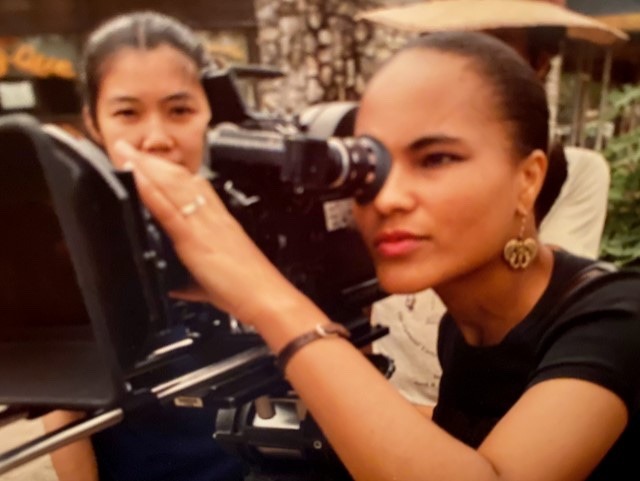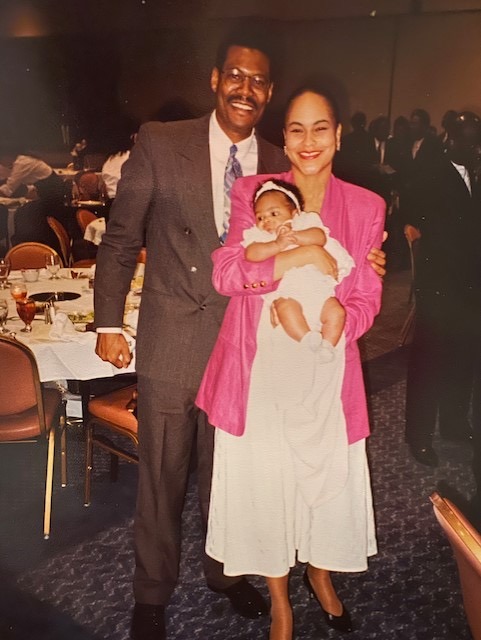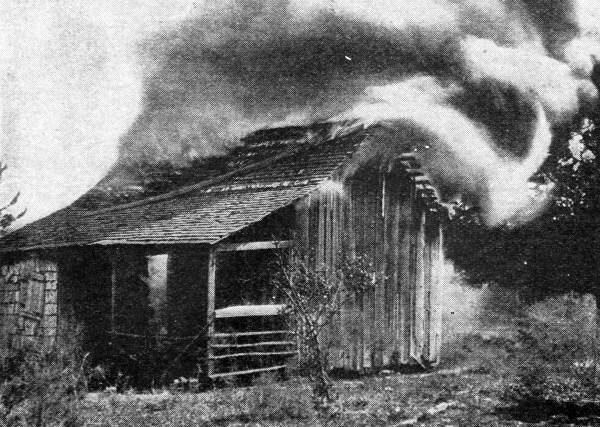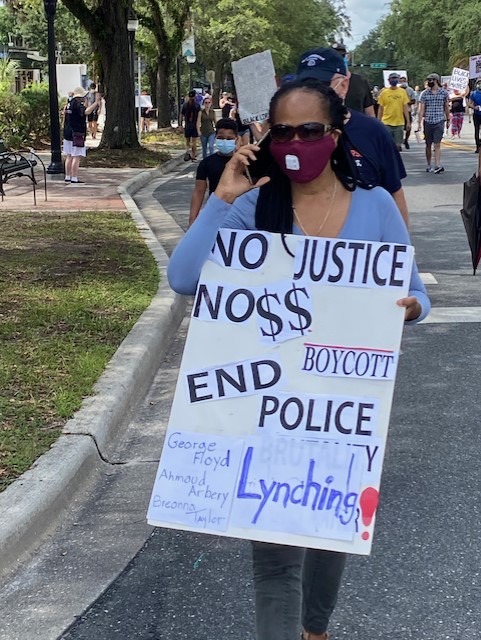How one Alachua County professor fought for racial justice by revealing the past — all while keeping her illness at bay

Patricia Hilliard-Nunn often wore a pendant of a mythical bird that represents the Ghanian word Sankofa, meaning “it is not taboo to fetch what is at risk of being left behind.”
January 30, 2023 | Story by Anna Guber | Illustration by Delia Sauer | Photos courtesy of Kenneth Nunn
Editor’s note: January 2023 marks the 100th anniversary of the Rosewood Massacre. Patricia Hilliard-Nunn researched this tragedy and others like it across the state, uncovering truths that were previously unknown to the public.
One summer morning in 2020, Kenneth Nunn woke his wife, Patricia Hilliard-Nunn, before sunrise so they’d have ample time for their upcoming journey. He packed his briefcase and her computer bag, and by 5, they had left their home in Gainesville for the drive to Jacksonville. In the car, they listened to reruns of Joe Madison and Sirius XM Progress.
Normally, she might have sat in the passenger seat grading papers or returning emails. But on this day, Patricia was preparing for a presentation.
That in itself was not unusual. Hilliard-Nunn was a renowned professor at the University of Florida and a tireless activist who had dedicated many of her 57 years to exposing America’s racial injustices. Without her work, many of the horrific crimes committed against Black people in Alachua County would not be widely known. And there might not have been any justice for the descendants of those who had suffered.
But this June day was different, though Hilliard-Nunn showed no signs of it.
When husband and wife arrived in Jacksonville, they navigated the sterile, antiseptic-smelling hallways to an upper floor of the Mayo Clinic. It was a floor for a specific type of treatment: transfusions.
Just beyond the waiting room’s double glass doors was another room with five or six green vinyl recliners. Poles attached to the chairs dangled bags of medicine that would course through patients’ veins.
Hilliard-Nunn focused on her presentation for the K-12 Teachers’ Summer Institute on Africa. She paid no attention to those chairs or the hours she would spend in one.
She immediately got to work. As she organized her slides, her husband set up a virtual Zoom background on her computer. No one, including the event director and her close friend, Agnes Leslie, knew she was in the hospital. Hilliard-Nunn made sure of it.
She never revealed that for the duration of that presentation, she was hooked to an IV, fighting for her life. That was just the way she was. She wanted no one’s pity. And she wanted nothing to impede her work.
That presentation would be the last time Leslie ever saw her friend.
But it was not the first time — nor the last time — Hilliard-Nunn found a way to balance her health and passion for researching and teaching Black and African American culture; for exposing racial injustice.
Bold beginnings
Hilliard-Nunn grew up in a family as extraordinary as the life she led. She spent her earliest years in San Francisco, until her father accepted a position as a consultant for the Peace Corps. Her family resettled 7,000 miles away in Liberia, where her father helped organize the country’s K-12 education system.
Hilliard-Nunn was immersed in African culture. Those years shaped her identity and inspired her life’s work. She was as much an African as she was an American and felt a sense of cultural belonging to the continent of her ancestors.
After five years in West Africa, the Nunn family moved back to America, where Hilliard-Nunn finished her high school education. She then earned a bachelor’s degree in mass media from Hampton University and later a master’s degree in film production from Howard University. It was there that she met the love of her life.

Hilliard-Nunn had a passion for filmmaking. While studying at Howard University, she directed a film exploring African contributions to Egyptian civilization, inspired by her father’s work. She taught two film classes at UF — Black Women and Film and Blacks in Film.
Nunn chuckles now as he recalls the story of how he met his wife. He is sure she would tell it differently.
Hilliard-Nunn’s version would involve a man who was too arrogant to be interested in girls and who ignored her when she waved to him from a few seats down in a classroom. She approached him after class to say she was waving at him.
But Nunn was already smitten; he had noticed her four months prior during a 1987 talk by famed photographer and film director Gordon Parks. Nunn thought she was the most beautiful woman he had ever seen. And after seeing her for the second time, he knew he couldn’t leave anything to chance.
Their first phone call lasted six hours. A first date followed. Then another.
Their love began to take root.
While working on a project exploring African contributions to Egyptian civilization, Hilliard-Nunn was accepted into Florida State University’s mass communications Ph.D. program. Though Nunn wanted her to stay in Washington, she was determined to continue her education. So he made sure she left with a ring on her finger.
The following fall, Hilliard-Nunn ventured to Tallahassee. Nunn, a public defender at the time, was intent on finding work in Florida. When asked to join the University of Florida Levin College of Law’s faculty, he accepted, moved to Gainesville, and married Hilliard-Nunn. All was well.

Hilliard-Nunn stands with her husband, Kenneth Nunn, and her daughter, Foluke, at a 1994 conference. She had moved to Gainesville in 1993.
But it wasn’t long before she began to hear whispers about Alachua County’s wretched past of slavery and Jim Crow cruelty.
Confronting a racist past
Maybe it was through her church. Maybe it was through her role as a lecturer in the African American Studies Department. Or maybe it was in 1993, when she met Lizzie Jenkins, a descendant of Black Floridians killed in the infamous Rosewood Massacre.
Jenkins spoke of a town made up of mostly Black residents that was burnt down following one white woman’s unfounded accusation that she had been assaulted by a Black man. Any Black resident who survived the massacre was forced out of Rosewood.

A white mob burned homes, businesses and churches in Rosewood after a Black man was accused of assault. (Photo courtesy of Florida Memory)
Hilliard-Nunn was intrigued by what she had heard.
Over the next two decades, she spoke with those willing to share their knowledge of the past, both in Rosewood and beyond. She collected their stories and unearthed the truth about the racially motivated atrocities that occurred; truths that might have otherwise laid buried, as they had been for a century.
In 2019, after almost three decades of working to expose racial injustice, Hilliard-Nunn contacted Warren Lee, a Jacksonville business owner related to three of the six people who were lynched in Newberry on August 18, 1916.
Hilliard-Nunn had heard stories about that day. She heard the false accusations white individuals made about a group of Black people stealing hogs. She heard that a Black man was shot and a crowd of 1,000 angry white people watched as five other Black people were hung from an oak tree.
The newspaper headlines of the day screamed that justice had been served. But the white mob gathered at that Newberry field took an oath: They would never discuss what they witnessed.

The Associated Press wrote an article about the Newberry Six lynchings, which was distributed to newspapers across the country. “No whites are reported hurt,” the piece published in the Ocala Evening Star on Aug. 16, 1916, noted. (Photo courtesy of Newspapers.com)
The truth about the grisly events that came to be known as the Newberry Six lynchings fell into obscurity until recent years, when Lee’s grandmother Eunice Myers began speaking out. She passed the story to Lee about their family members who were murdered: James Dennis, his brother Bert Dennis and his sister Mary Dennis, who was pregnant at the time.
Lee, 57, had never shared his family’s story with anyone. It was generational fear; Black people had been terrorized and threatened for so many years. But he saw authenticity in Hilliard-Nunn’s eyes and was struck by her devotion.
Before Myers died at 102, she gave Lee permission to share what he knew with Hilliard-Nunn.
Hilliard-Nunn met with Lee for nine weeks in 2019. He told her what he had learned from his grandmother: A dispute had erupted over the 2,000 acres of land his family owned in Jonesville, then a predominantly Black community of farmers who grew corn and peanuts and raised chickens. Myers told Lee that white authorities threatened her grandmother, Julia Dennis, Jim Dennis’s wife. If she refused to give up her family’s land or even uttered a word about what led to their murders, she would meet the same fate.
Hilliard-Nunn documented all she learned from Lee. It was a hard history to digest. As a Black woman, she felt the pain of Lee’s family. But through the pain, she delivered. Had it not been for Hilliard-Nunn, Lee says it’s unlikely he would have ever revealed the truth of his family’s past.
Newberry Mayor Jordan Marlowe credits Hilliard-Nunn with uniting the town’s community, which voted in 2017 to engage in a painful process of truth and reconciliation that has included public gatherings. For descendants and residents of the city, it also entails tough soul-searching.
Without her work, Marlowe says, “We wouldn’t have been able to come together as a community and say this isn’t questionable. We know these things happened and we should work to atone for them and reconcile with our neighbors.”
Newberry has since formed a partnership with the Equal Justice Initiative, a racial justice nonprofit that in 2018 opened a legacy museum and memorial in Montgomery, Alabama, to remember those who suffered under slavery and Jim Crow.
With its help, Newberry erected two historical markers and held a ceremony to collect soil from the field where the lynchings occurred.
At a 2019 memorial held at Pleasant Plain United Methodist Church, Hilliard-Nunn spoke of how she drew inspiration for her work from Sankofa, a Ghanian word that means “it is not taboo to fetch what is at risk of being left behind.” The word is represented by a mythical bird that has come to symbolize the memory of ancestors. Hillard-Nunn wore a Sankofa pendant close to her heart, and its meaning is infused with her body.
It was no good to just look back, she believed, but to seek rebirth from the past.
The brutality she discovered from speaking with descendants like Lee extended far beyond the Newberry lynchings, she concluded. She spoke of how much work was left to be done, forever committed to the fight to shed light on stories that had been erased.
As she waved her Sankofa in the air, she never revealed that she was fighting a second battle: her own against cancer, which she had grappled with since 2014.

Hilliard-Nunn speaks at the Harn Museum, teaching an audience about African fabrics. In addition to history, she also had a deep passion for teaching about African and Black fashion and hairstyles.
Those in attendance may have known she was dealing with illness, but no one knew how serious it was. Except perhaps Lee. Just weeks before, Hilliard-Nunn had opened up to him about how fast her health was deteriorating. She rarely spoke of her own sickness — but now, her work had to take precedence. Time was running out.
Lee looked at Hilliard-Nunn in disbelief. His first response was to halt the project. But she wanted to keep going, to finish the work she had started.
“I have to pour all of me into this, because I don’t really know how much time I have left,” Lee remembers her telling him.
Leaving a legacy
Over the next year — despite the COVID-19 pandemic and the progression of her disease — Hilliard-Nunn, steely as ever, fought on.
She celebrated the 50th anniversary of UF’s African American Studies Department. She rallied among the hundreds who marched through the streets of Gainesville for George Floyd.

Hilliard-Nunn was one of hundreds in Gainesville who marched in Black Lives Matter protests following the police killings of George Floyd, Ahmaud Arbery and Breonna Taylor. She held a poster comparing police brutality to lynching.
On June 19, 2020, at a protest to protect historic Black communities from gentrification, Hilliard-Nunn stood in front of the A. Quinn Jones Center and called out to members of the community.
“When you stand together, love one another, study and focus, there’s nothing you can’t do,” she roared. Her passion shone through brightly.
Perhaps that’s why six days later she was able to conceal what was happening on the other side of her computer screen, as she sat in a green vinyl recliner, receiving a blood transfusion while presenting at Agnes Leslie’s Summer Institute on Africa.
A month later, just days before her 58th birthday, Hilliard-Nunn was admitted to the hospital; her health had worsened. After a week, her doctors told her they had run out of options.
She and her family made the decision to go home.
On August 5, 2020, Leslie was planting hydrangeas and watering her backyard garden. Though it was only around 10 a.m., the Gainesville summer air had grown thick, and sweat dripped down her face in the heat.
She went inside to cool off. Soon, sweat would turn to tears. At 10:56, she read a friend’s text. Her heart crumbled with each word.
“Patricia Hilliard-Nunn passed away early this morning.”
The loss was crushing to Leslie and all those who knew Hilliard-Nunn.
As the news traveled, it shocked even the few people whom Hilliard-Nunn had opened up to about her health. No one could believe that the woman of steel and smiles had died.
Months after her death, in February 2021, over 50 people gathered in Newberry to collect soil in honor of those who were lynched more than a century before. Even though she could not attend, Hilliard-Nunn’s spirit was felt throughout — and her work still impacts people today.
“She left a legacy of how to think about life beyond ourselves,” Leslie said. “Given all she went through, she could have stayed in her corner. But she had an unselfish love for the community and a passion for teaching others a history that connects us all.”